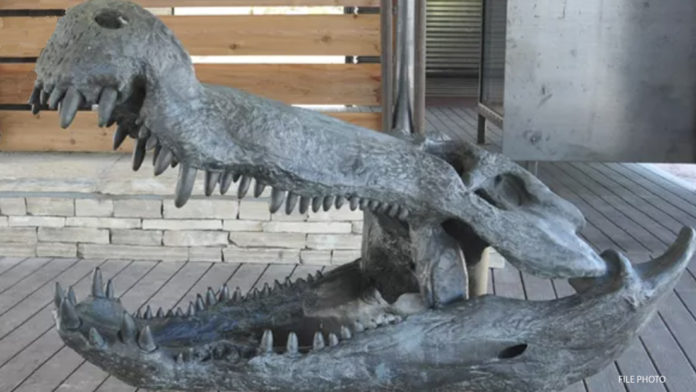***For All Things Wyoming, Sign-Up For Our Daily Newsletter***
By Ellen Fike, Cowboy State Daily
A group of Japanese researchers has discovered a fossil near Laramie of a 14-foot dinosaur considered to be the “uncle” of modern crocodiles, according to a recently published research study.
A team of researchers from Hokkaido University have identified a new species belonging to the crocodile-like “goniopholidid” family. The full findings of the study were published in the journal Royal Society Open Science
The fossil of ‘Amphicotyleus milesi” was unearthed in Albany County’s East Camarasaurus Quarry, named after the type of dinosaur remains most often found at the site.
According to the paleontologists, in life the 14-foot long A. milesi would have weighed in at nearly one-half ton and sported a mouth packed with 30 2-inch-long, razor-sharp teeth. The “crocodile” would have lived during the late Jurassic period, around 200 million years ago.
Noted Wyoming outdoorsman Paul Ulrich, whose family owns Ulrich’s Fossil Gallery in Kemmerer, was impressed with the massive size of the crocodile fossil.
“Wyoming has one of the richest deposits of fossils in the world,” he said. “This particular fossil was found in the Morrison formation, which is actually somewhat older than the formation we excavate. This shows crocodiles have been in Wyoming, literally, from the Jurassic period for tens of millions of years.”
Wyoming’s fossil deposits are so rich, Ulrich believes some will remain undiscovered forever.
According to paper author and paleontologist Junki Yoshida, A. milesi had a unique breathing system that it used for diving, which Ulrich found fascinating.
“That evolution allowed crocodiles to breathe underwater for up to an hour now,” he said.
Ulrich said he considers himself a conservationist but isn’t saddened that the gigantic crocodile-like creature became extinct.
“Let’s face it, this is not something you’d want to run into while you’re out fly-fishing in Wyoming,” Ulrich said. “It could really ruin your afternoon.”
That being said, Wyoming didn’t look much like Wyoming 200 million years ago. Scientists say the badlands of Wyoming looked more like the Serengeti of Africa back in the Late Jurassic period.
Modern crocodiles live in tropical areas in Asia, the Americas, Africa and Australia.
The researchers believe that A. milesi would have been an opportunistic predator, eating everything from small fish, frogs, lizards and turtles to even herbivorous dinosaurs and pterosaurs.
“Can you imagine that monster in a ring with a grizzly,” Ulrich said. “Pay-per-view gold.”
***For All Things Wyoming, Sign-Up For Our Daily Newsletter***
Credit: Source link






























